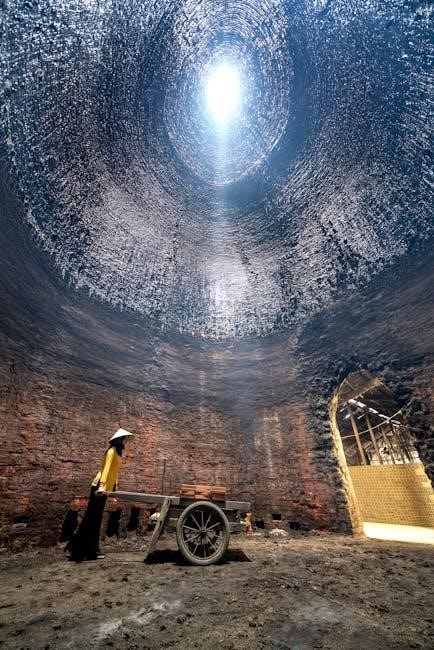The poem, part of William Carlos Williams’ 1923 collection Spring and All, is celebrated for its vivid imagery and symbolic depth, showcasing the beauty in everyday scenes through its concise yet powerful language.
1.1 Background of the Poem
Written by William Carlos Williams in 1923, The Red Wheelbarrow was first published in his collection Spring and All. The poem is renowned for its brevity and vivid imagery, capturing a moment in time through a simple yet profound scene. Rooted in the Imagist movement, it emphasizes clear and concise language, focusing on precise images over elaborate descriptions. The poem’s structure, consisting of just four lines arranged in free verse, reflects Williams’ experimentation with form. By omitting punctuation and rhyme, he creates a direct and unfiltered observation of the world. The central image of the red wheelbarrow glazed with rainwater, placed beside white chickens, symbolizes the intersection of labor, nature, and everyday life. Williams’ intent was to elevate the ordinary, inviting readers to find meaning in the mundane, a hallmark of his poetic philosophy.
1.2 The Author: William Carlos Williams
William Carlos Williams was a prominent American poet, short story writer, and a key figure in the Imagist and Modernist movements. Born in 1883 in Rutherford, New Jersey, he balanced a successful medical career with his passion for writing. Williams’ work is celebrated for its focus on the ordinary, often using local and personal experiences to explore universal themes. His poetry emphasizes precision and clarity, rejecting traditional forms in favor of free verse and fragmented structures. The Red Wheelbarrow exemplifies his ability to transform a simple scene into a profound meditation on life. Williams’ contributions to poetry were recognized with the Pulitzer Prize in 1963, a year before his death in 1964. His legacy endures as a master of capturing the essence of the everyday through innovative and evocative language.
1.3 The Significance of the Red Wheelbarrow
The red wheelbarrow in William Carlos Williams’ poem holds profound symbolic meaning, transcending its ordinary appearance. It represents the beauty of the mundane and the importance of observation. The vivid image of the wheelbarrow glazed with rainwater, contrasted with the white chickens, highlights the interplay of colors and textures, emphasizing the uniqueness of everyday moments. This poem, with its simplicity, challenges readers to find meaning in overlooked details. The lack of punctuation and rhyme further underscores the directness of the image, making it a quintessential example of Imagist poetry. The red wheelbarrow thus becomes a metaphor for the extraordinary hidden within the ordinary, inviting readers to reflect on the significance of their surroundings. Its brevity and clarity have made it a timeless piece, celebrated for its ability to evoke deep contemplation through a fleeting scene.

Major Themes in “The Red Wheelbarrow”
Highlighting labor’s significance, nature’s role, and Marxist undertones, the poem underscores the extraordinary in the ordinary through its imagery and simplicity.
2.1 The Greatness of Labor
The red wheelbarrow embodies the quiet dignity of labor, symbolizing the essential yet often overlooked tools of work. The poem elevates the mundane to highlight the beauty in everyday efforts, reflecting the importance of human toil in creating meaning. Through its imagery, Williams celebrates the ordinary worker’s contribution, suggesting that even simple objects hold profound significance. This theme aligns with Marxist ideals, emphasizing the value of labor and the working class. The wheelbarrow, glazed with rainwater, stands as a testament to the enduring presence of labor in our world, reminding us to appreciate the invisible efforts that sustain our lives.
2.2 The Intervention of Nature
The poem highlights the interplay between natural elements and human-made objects, with the red wheelbarrow glazed by rainwater, symbolizing nature’s transformative touch. The rainwater adds a layer of freshness and vitality, emphasizing the wheelbarrow’s presence in the scene. The white chickens nearby further underscore the integration of nature into the setting, creating a vivid contrast between the vibrant red and the purity of white. This juxtaposition reflects the idea that nature intervenes in human-made environments, infusing them with life and meaning. The imagery suggests that even in mundane scenarios, natural elements can elevate the ordinary into something extraordinary, drawing attention to the interconnectedness of all things. Williams’ focus on these details invites readers to appreciate the subtle yet profound ways nature influences our daily lives and perceptions.
2.3 Marxism and Its Reflection in the Poem
The poem subtly reflects Marxist themes through its imagery and symbolism. The red wheelbarrow, a tool of labor, signifies the proletariat’s essential role in society. Its red color may symbolize socialism or communism, highlighting the importance of labor. The phrase “so much depends” emphasizes the reliance on this simple tool, akin to how Marxist theory underscores the proletariat’s crucial role in production. The wheelbarrow, glazed with rainwater, connects labor to nature, echoing Marx’s ideas on the alienation of labor under capitalism. The adjacent white chickens contrast with the wheelbarrow, possibly representing purity or simplicity coexisting with labor. The poem’s minimalist structure mirrors the unadorned nature of labor itself. Thus, while not explicitly Marxist, the poem aligns with Marxist principles by valorizing labor and its tools, suggesting their fundamental role in societal functioning.
Structure and Form of the Poem
The poem employs free verse, emphasizing imagery over traditional rhyme or meter. Its concise, fragmented lines create a stark, visual impact, mirroring the simplicity of the scene described.
3.1 Free Verse and Its Implications
William Carlos Williams’ use of free verse in The Red Wheelbarrow allows for a fluid, natural representation of thought and image. By abandoning traditional poetic structures, the poem achieves a raw, unfiltered quality that mirrors the simplicity of the scene it captures. This freedom from rigid rhyme and meter lets the reader focus on the imagery and symbolism, emphasizing the idea that meaning can emerge from the ordinary. The lack of punctuation further enhances the directness of the poem, making it feel spontaneous and immediate. This approach aligns with the Imagist movement’s emphasis on clear, concise language and precise images. Through free verse, Williams creates a sense of intimacy and immediacy, drawing the reader into the quiet yet profound moment depicted.
3.2 The Use of Lineation
The lineation in The Red Wheelbarrow plays a crucial role in shaping the poem’s imagery and rhythm. Each line break introduces a new element, slowly building the scene: “so much depends,” “upon,” “a red wheel,” “barrow,” and so on. This fragmented structure forces the reader to focus on each word and image individually, emphasizing the significance of everyday objects. The short, staggered lines create a sense of deliberateness, mirroring the careful observation of the scene.
The line breaks also contribute to the poem’s rhythm, which is slow and meditative. This structure aligns with the Imagist principle of clear and precise images, allowing each part of the scene to stand out. The lack of punctuation and the fragmented lines enhance the directness of the poem, making it feel immediate and vivid. Through its lineation, Williams invites the reader to experience the scene as if they are discovering it for the first time.
3.3 The Absence of Punctuation and Rhyme
The absence of punctuation and rhyme in The Red Wheelbarrow is a deliberate stylistic choice that enhances the poem’s clarity and directness. Without punctuation, the reader is not guided through the text in a traditional way, forcing a focus on the imagery and the natural flow of the words. This lack of punctuation creates a sense of simplicity and immediacy, drawing attention to the concrete objects described.
The omission of rhyme allows the poem to avoid musicality and instead emphasizes the quiet, observational tone. This approach aligns with the Imagist movement’s emphasis on clear and precise language, free from unnecessary ornamentation. The straightforward presentation of the scene underscores the idea that meaning can be found in the ordinary, without the need for embellishment. This minimalistic approach makes the poem feel raw and unmediated, further highlighting the significance of the everyday moment captured.

Imagery and Symbolism
The poem’s vivid imagery, such as the red wheelbarrow and white chickens, creates a stark visual contrast, symbolizing the ordinary yet profound moments in life, inviting deeper interpretation and reflection.
4.1 The Red Wheelbarrow as a Central Image
The red wheelbarrow is the poem’s focal point, symbolizing ordinary beauty and significance. Its red color stands out, evoking imagery of vitality and labor. Glazed with rainwater, it embodies simplicity and clarity, contrasting with the white chickens, highlighting purity and everyday life. This image, central to the poem’s meaning, invites readers to reflect on the profoundness of mundane objects. The wheelbarrow’s presence, devoid of embellishment, underscores Williams’ belief in the beauty of the ordinary. Its placement beside the chickens further emphasizes the interplay between nature and human-made objects, creating a balanced yet dynamic scene. This central image has become iconic in modernist poetry, illustrating the power of precise observation and the elevation of the commonplace to an art form. The wheelbarrow’s simplicity and vividness resonate deeply, making it a lasting symbol of poetic imagery.
4;2 The Contrast Between Red and White
The poem’s striking contrast between red and white enhances its visual and symbolic impact. The red wheelbarrow, vibrant and bold, represents human labor and vitality, while the white chickens embody purity and natural simplicity; This color dichotomy creates a balanced yet dynamic scene, drawing attention to the everyday details Williams celebrates. The red symbolizes energy and the human-made, contrasting with the white, which reflects calm and the natural world. This juxtaposition underscores the poem’s themes of labor and nature, inviting readers to appreciate the interplay between these elements. The clarity of the colors, unobscured by rhyme or punctuation, allows the imagery to shine, reinforcing Williams’ belief in the power of precise observation. This contrast is central to the poem’s enduring appeal, making it a masterpiece of modernist poetry.
Analysis of the Poem
The Red Wheelbarrow is a masterpiece of brevity, using vivid imagery to elevate the ordinary. Its concise structure and lack of punctuation emphasize the power of simple, precise observation, inviting deep reflection.
5.1 The Power of Observation
William Carlos Williams’ The Red Wheelbarrow exemplifies the power of observation through its vivid imagery and precise language. The poem invites readers to slow down and notice the mundane, transforming the ordinary into the extraordinary. By focusing on a red wheelbarrow glazed with rainwater beside white chickens, Williams underscores the idea that meaning can be found in the simplest of scenes. The structure, with its short lines and lack of punctuation, mirrors the act of observation itself—each line forces the reader to pause and absorb the details. This technique encourages a deeper connection with the world around us, highlighting how observation can reveal profound significance in everyday life. The poem thus serves as a testament to the transformative power of paying attention, a central theme in Williams’ work.
5;2 The Beauty of the Ordinary
The Red Wheelbarrow masterfully illustrates the beauty of the ordinary by elevating a mundane scene to a level of profound significance. Williams’ poem captures a moment in time—a red wheelbarrow glazed with rainwater beside white chickens—and transforms it into a meditation on the essence of existence. The simplicity of the image belies its depth, as the poem invites readers to appreciate the overlooked details of everyday life. The contrasting colors of red and white intensify the scene, drawing attention to the vividness of the ordinary. This focus on the commonplace reflects Williams’ belief that poetry should derive from the concrete world around us, where even the most familiar objects hold extraordinary meaning. The poem thus becomes a celebration of the beauty inherent in the everyday, encouraging readers to find significance in the world they often overlook.
Historical Context
The Red Wheelbarrow was first published in 1923 within William Carlos Williams’ collection Spring and All, a seminal work in modernist poetry that blended prose and verse to explore themes of renewal and perception.
6.1 Publication in “Spring and All”
William Carlos Williams’ poem, The Red Wheelbarrow, was first published in 1923 as part of his collection Spring and All. This collection was groundbreaking, blending prose essays with poetry to explore themes of renewal and modernist experimentation. The poem itself appears without a title in the original text, labeled simply as “XXII,” reflecting Williams’ minimalist approach. Spring and All was a pivotal work in Williams’ career, showcasing his ability to find profound meaning in ordinary imagery. The inclusion of The Red Wheelbarrow highlighted his commitment to Imagism, a movement emphasizing clear, concise depictions of everyday life. The poem’s brevity and vivid imagery resonated with readers, establishing it as a cornerstone of modernist poetry. Its publication in Spring and All marked a significant moment in Williams’ exploration of the intersection of art and the mundane.
6.2 The Influence of Imagism
The Red Wheelbarrow exemplifies the principles of Imagism, a poetic movement emphasizing clarity, precision, and the presentation of concrete images. This movement, influential in the early 20th century, sought to strip poetry of unnecessary ornamentation, focusing instead on direct, unadorned language. Williams, a key figure in Imagism, uses the poem to illustrate the power of observation and the significance of everyday objects. The vivid image of the red wheelbarrow, glazed with rainwater and set against white chickens, embodies the Imagist ideals of clear, concise depiction. By avoiding traditional rhyme and punctuation, Williams creates a sense of immediacy, drawing the reader into the scene. The poem’s simplicity and focus on a single moment reflect the broader Imagist goal of capturing the essence of modern life through precise, evocative imagery. This approach revolutionized poetry, emphasizing the beauty found in the ordinary and the importance of careful observation.

Where to Download “The Red Wheelbarrow” PDF
The Red Wheelbarrow PDF can be downloaded from popular academic platforms like Google Scholar, JSTOR, or university libraries. Ensure to use legal and free sources for access to this literary work.
7.1 Popular Platforms for Download
Several platforms offer easy access to The Red Wheelbarrow PDF. Google Scholar provides academic sources, while JSTOR and university libraries offer authorized downloads. Additionally, platforms like LitCharts and Scribd feature study guides and analyses, enhancing understanding of the poem. These sites ensure accessibility for students and researchers, promoting deeper engagement with William Carlos Williams’ work. Always opt for legal sources to support intellectual property rights and obtain high-quality documents.
7.2 Legal and Free Sources
Accessing The Red Wheelbarrow PDF legally and for free is possible through reputable platforms. Google Scholar offers academic sources, while many university libraries provide free access to the poem through their databases. Websites like PDFDrive and ManyBooks also host free versions of the poem, ensuring compliance with copyright laws. Additionally, platforms like Project Gutenberg and public domain repositories often include works by William Carlos Williams. These sources are ideal for students and researchers seeking high-quality, legally accessible materials. Always prioritize verified sources to ensure authenticity and avoid infringing on intellectual property rights. Legal downloads not only respect the author’s work but also guarantee a seamless reading experience.

Study Guides and Analysis
LitCharts offers comprehensive guides, expert analysis, and quizzes for The Red Wheelbarrow, providing deep insights into themes, structure, and symbolism. These resources enhance understanding and facilitate educational engagement.
8.1 LitCharts and Expert Analysis
LitCharts provides a detailed analysis of The Red Wheelbarrow, offering insights into its themes, structure, and poetic devices. Their guides highlight the poem’s focus on the ordinary, emphasizing how Williams transforms a simple scene into a profound reflection on life. The analysis explores the imagery of the red wheelbarrow and white chickens, explaining their symbolic significance. It also delves into the poem’s free verse style, lineation, and lack of punctuation, which contribute to its modernist appeal. LitCharts’ expert commentary helps readers understand the historical context, including the influence of Imagism and Williams’ unique approach to poetry. The guide also discusses Marxist interpretations, linking the poem to broader societal themes. Additionally, LitCharts offers downloadable PDF guides, making it easier for students and educators to access comprehensive study materials. These resources are invaluable for deeper engagement with the poem’s meaning and artistic craft.
8.2 Quizzes and Educational Resources
Various educational platforms offer quizzes and resources to deepen understanding of The Red Wheelbarrow. LitCharts provides interactive quizzes to test comprehension of the poem’s themes, structure, and symbolism. These tools are designed to help students engage critically with the text. Additionally, downloadable PDF guides and worksheets are available, featuring detailed questions and prompts for analysis. Many websites offer printable exercises for classroom use, focusing on imagery, metaphor, and the poet’s intent. These resources are particularly useful for educators seeking to create engaging lesson plans. Online forums and educational apps also provide interactive discussions and games to explore the poem’s nuances. Such tools make learning about The Red Wheelbarrow both accessible and engaging for students of all levels, fostering a deeper appreciation for Williams’ work and its place in modernist poetry.
